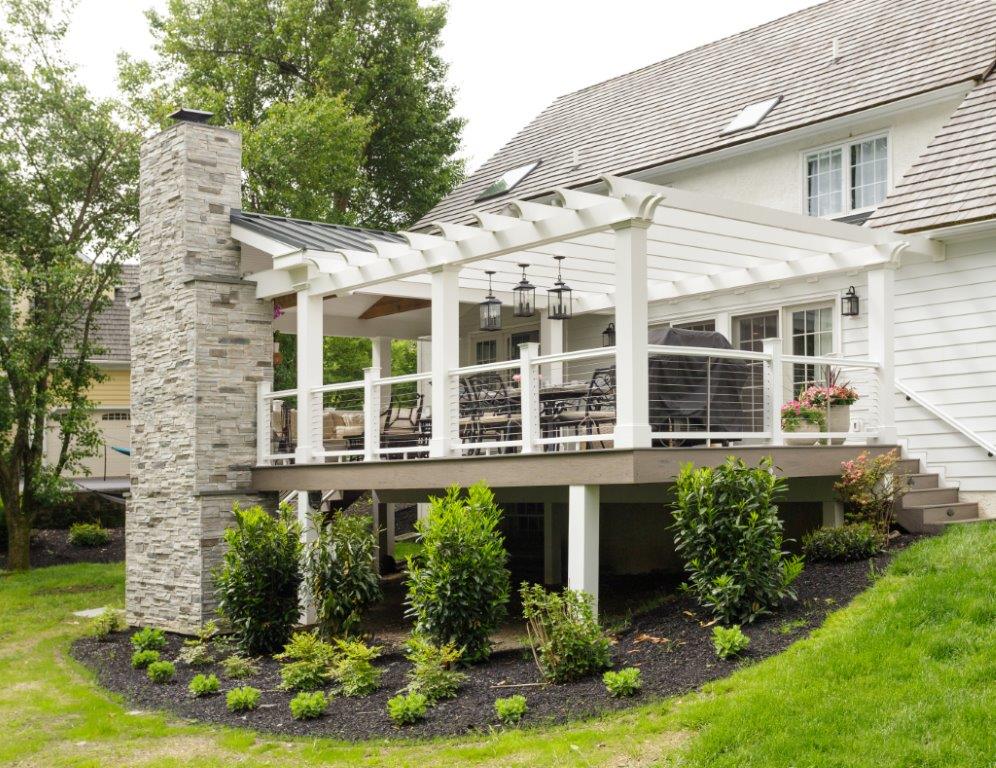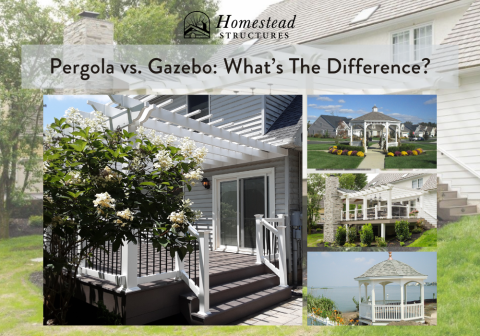Pergolas and gazebos are two of the most common backyard structures. However, these two structures are often confused with one another, and they have similar traits as other backyard amenities. In addition to subtle structural differences, these different backyard features may require specific placements and other elements like walkways, plants, or lighting.
Pergolas and gazebos provide additional areas that you can use to relax, host guests, or enhance the appearance of your yard. They can also increase home value and curb appeal, making them a good investment for many homeowners.
Here is what you need to know when deciding if a pergola or gazebo is the best backyard addition for your budget and lifestyle.
What Is a Pergola?
A pergola has four or more support posts and a top section with cross beams or latticework. The beams are not covered with a roof. Instead, they are meant to support vines or other creeping plants. The homeowner plants climbing or rambling plants that grow during the spring and summer and cover the top beams. These living elements provide shade, color, and volume. Depending on the species and spacing of the beams, the plants can give full or partial shade.
While you do not have coverage during non-growing seasons, pergolas facilitate natural light and airflow, providing comfortable conditions to users even during warmer months.
A pergola can sit next to a house or over part of a patio or deck to offer atmosphere and partial shade. As stand-alone structures, they can create an attraction in a garden or portion of the lawn that you would otherwise not use.
Builders can use various materials for these structures, but wood and vinyl pergolas offer attractive appearance and durability. Pergolas are relatively simple, but they need to be strong and weather-proof because they are permanent and will be exposed to climate throughout the year.
What Is a Gazebo?
A gazebo is a freestanding, open-sided structure with a solid roof and usually a floor. Many gazebos have low walls that allow the use of screens or other features.
Gazebos provide shade, but they also offer more shelter than the other backyard installations, as the solid roof protects users from the elements.
Because gazebos are free-standing structures, they are typically placed away from the house, though placement can vary depending on the size of the backyard and the gazebo.
Pavilions also have a permanent roof, but they have no built-in floor and rely on corner supports without additional partial walls. Similarly, ramadas are a Southwestern-style version of a pavilion. Some designs have partial walls, but they lack a complete floor like a gazebo.
Pavilions and ramadas often cover patios, paving stones, or other cement or rock bases. In comparison to gazebos, which are rounded or have a hexagonal or octagonal shape, pavilions and ramadas are typically square or rectangular.
Gazebos vs. Pergolas: How Do They Compare?
The primary difference and first consideration when choosing between gazebos and pergolas is the roof. Gazebos have a solid covering while pergolas rely on living plants to provide partial or full shade.
The comparison goes beyond this one structural difference. The two options require different placements in the yard, and they have unique building requirements and differing price tags.
Gazebos Provide More Shelter than Pergolas
Gazebos provide more shelter than pergolas. With the right plant choice, pergolas can provide ample shade during the height of the growing season. However, for the rest of the year, there will only be partial protection from the sun.
Because gazebo roofs are solid, they provide more shelter throughout the year. This protection goes beyond shade. Gazebos can protect users from rainfall and other forms of precipitation.
Technically, a gazebo could be a year-round backyard feature. Designs with partial walls can sometimes support screens or windows, and space heaters could also help increase comfort in colder months in four-season climates. You might also opt to add curtains to increase privacy inside a gazebo.
Those seeking a structure for year-round use or use in rainy conditions should consider a gazebo instead of a pergola.
A Gazebo Is Typically Located Away from the House
Both gazebos and pergolas are free-standing, so placement options are flexible. However, gazebos are typically further away from the home because the more substantial structure might crowd the home if placed too close to it. House awnings and other coverings are a better choice for coverage near the home, because these can provide outdoor shade without limiting space.
On the other hand, a properly placed gazebo can also allow you to take advantage of the most natural areas of the backyard while still protecting from sun and rain. This is because gazebos allow you to take advantage of these spaces that typically sit further from the home.
A Pergola Can Be Constructed Anywhere
Pergolas offer a lot of placement options. Like gazebos, they are free-standing, so they can go anywhere in the yard. They could cover a patio or walkway or sit above a sitting area made with paving stones near the garden.
 You could also place them by elements you use seasonally. For instance, pergolas will provide full shade during the summer when you use an in-ground pool. This seasonality makes them an excellent choice for a pool deck or pool house.
You could also place them by elements you use seasonally. For instance, pergolas will provide full shade during the summer when you use an in-ground pool. This seasonality makes them an excellent choice for a pool deck or pool house.
Because they lack a built-in floor, pergolas are easier to construct. As long as the supports are on stable ground, the structure can stand on uneven surfaces or cover paved pathways, lawns, gardens, or any other backyard elements.
The flexibility and ability to select various types of plants give you many different options for adding a pergola to your yard.
Pergolas Are Typically Less Expensive than Gazebos
Pergolas require fewer materials and do not have elements like a floor or solid roof. The simpler design and building process makes them a less costly option than gazebos.
Pergolas cost $3,594, on average (if you're looking for a 10x10 or 10x12 pergola). Because there are so many size and material options, the price for an average structure can range from $1,966 to $5,230. Meanwhile, high-end models come in at around $9,000.
Size and materials can affect cost. Pergolas are wood, vinyl, metal, or fiberglass. Some may incorporate other elements, like stone.
For comparison, HomeAdvisor puts the range for gazebos between $2,688 and $9,847, with the budget for a custom-built option reaching $11,000. The national average for pre-packaged gazebos is $5,724 (as of July 19, 2022).
Both Types of Structures Can Add Value to Your Home
The choice comes down to how you use your yard during different seasons and how much shelter you need. You can also consider your plans for entertaining, outdoor dining, and events you might host.
In some ways, there is no incorrect choice. Both provide many of the same benefits.
-
Both provide shade and shelter for a lounging space. Depending on the seasons, guests will be comfortable under either structure.
-
Both can contain or protect other enhancements, like a deck, patio, or outdoor kitchen.
-
Both structures can add value to your home. The National Association of Realtors and the National Association of Landscape Professionals also found that any outdoor features that improve appeal can increase the attractiveness of a home to buyers. In addition, a 2022 survey of 1,250 real estate agents by Trees.com found that 42 percent of the agents thought that a gazebo was the most important outdoor element for the value of a home.
Finally, once built, both structures require limited care. You may need to trim vines on a pergola after they reach the desired length and density, but this job requires a limited amount of time once or twice during the summer.
Pergola or Gazebo: Which One Should You Choose?
Ultimately, the choice between a gazebo and a pergola comes down to your use plans, budget, and vision for your backyard. You might also consider other structures, like backyard pavilions or simple arbors.
You can ask yourself specific questions about how you plan to use your backyard and any structures you build. For instance, you might decide whether you want a space for quiet relaxation and book reading or need an area to entertain. You can also ask if your structure is meant for family use or if you plan to use it to host guests for al fresco dinner and drinks.
Once you define these potential uses, the choice between a pergola, gazebo, or other backyard building will be easier.

Facebook Comments Box